Have you ever had a raccoon as a pet? Or have you experienced a raccoon’s damage to your property? The answer might be yes or no. Though raccoons are wild animals, some people choose them as their pets and enjoy their company. However, raccoons are called fierce mammals. They are amiable animals and attract people with their incredible facial masks. They prefer to live in urban areas to get access to a variety of meals and build their nests and dens on residential properties. In this article, you are going to find a wide range of information about raccoons and what attracts them in general to urban areas. and prevent raccoons from choosing your home as their abode.
North and Central America, Europe, and Japan are home to raccoons. Because of their great adaptability, they can survive in a variety of environments and climates. They usually build their dens in caves or trees, although they can also live in barns, abandoned cars, and other man-made places. It is a reality that raccoons are more than willing to live with people, but when people approach them, they may become aggressive. The Human Society states that because raccoons are frequent carriers of leptospirosis, roundworms, and rabies, humans should exercise extra caution while approaching them. The majority of specialists advise against keeping a raccoon as a pet. Learn here how to prevent raccoons from choosing your home as their abode and other facts, like what makes them think food is in your home and how to get rid of raccoons.
What makes raccoons think food is in my Home?
Raccoons have strong senses, which would help them attract and find what they need. Your house might provide various food sources, or perhaps it is located near a food source that enables them to get to their kitchen quickly. Raccoons are omnivores and ingest anything that comes in front of them. They are not picky, and whatever comes at a time would be their favorite meal. One of the main things that draws raccoons to a home or property is the presence of food and easy access to it.
Raccoons consume a variety of foods since they are omnivores. If your favorite treat is arranged so that they can readily reach it and enjoy themselves stress-free, they will appreciate coming over to your house frequently. Fallen fruit, readily available feeders, and trash cans filled to the brim with meat all serve to enhance the likelihood that raccoons will make a permanent home and increase the frequency of their visits.
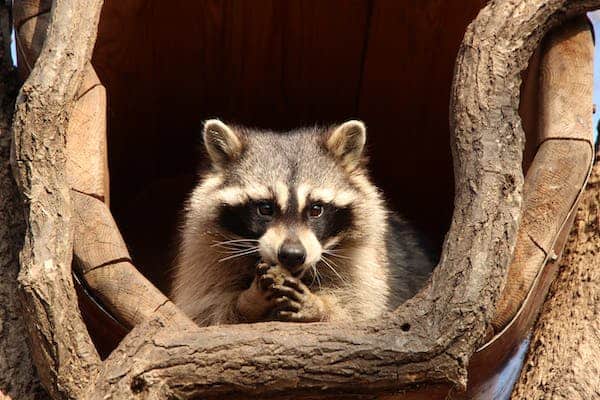
What can you do to prevent raccoons from choosing your home?
Raccoons are animals that fancy resourceful arenas; a house with many resources, such as a safe place, a good yard, a warm chimney, and attics, would inspire raccoons to live there. If at all possible, you should keep raccoons away from your property. There are traps available, but cleaning them out can be difficult and harsh on the animals. Any little animals that come onto your property run the risk of being poisoned. The best course of action is to completely discourage raccoons from entering your property. It is important to mention that simply not giving raccoons a reason to visit your property is one of the best methods to discourage them. Since raccoons are almost always searching for food, the first step in keeping them at bay is to remove their food source.
What to do if you have a raccoon nuisance?
You will find it difficult to deal with a raccoon with your bare hands. However, raccoons are small mammals, and they can hurt you if you try to remove them from your property. Because whenever they feel a threat from whoever approaches, they will take an aggressive position and literally assault you. Hence, the best possible way to make yourself comfortable with raccoons’ nuisance is. Determine where raccoons hide, take away their food supplies, block off entryways, and use live traps to catch any that are still there. Trash cans that have fallen over, footprints, droppings, and odd noises like mewing, whistling, and growling are indications of a raccoon infestation.

How to get rid of and prevent raccoons?
If you fail to prevent raccoons from entering your home, then you must follow the steps below to get rid of raccoons. Yes, it seems that you have encountered a raccoon problem because you are looking for information on how to get rid of them. Actually, getting rid of raccoons is not an easy task on your own because you definitely find it difficult to deal with it. Some people believe that being harsh to raccoons would assist them in getting rid of raccoons. The first step in removing raccoons from an area is to determine their presence. Since they are typically seen at night, you might not see one to be sure they are present.
In addition, raccoons seek out three items when they enter your yard: food, water, and shelter. They won’t have any reason to stay if they don’t locate any. Thus, the best defense against raccoons in your yard is to ensure that they won’t locate what they’re after. You must have a rough idea of what raccoons enjoy and dislike in order to effectively eradicate them. It will take some time and work to get rid of them, but you can do a few things around your home to prevent raccoons. There isn’t a single strategy to permanently repel raccoons. Nonetheless, unless the population is extremely large, modest, reasonable steps are frequently sufficient to control it. However, there are certain ways to prevent them from breaking into your property.
Ways to Get Rid and Prevent Raccoons in Your Yard
It’s important to comprehend raccoon behavior before deciding whether or not to remove them from your property. Because they are nocturnal animals, raccoons are most active at night. Throughout the day, raccoons are frequently spotted rummaging for food. Most of the time, you can spot them at night in your backyard. They don’t intentionally hurt you or your pets. Instead, they enter your yard in search of food and shelter. Not every wild raccoon is a threat or is always rabid.
Notwithstanding this, raccoons remain wild creatures. If they are cornered, they may attack and infect others with rabies or other diseases. If they start to become bothersome or frequent visitors, you shouldn’t ignore them and learn to prevent raccoons. Surely, this knowledge will enable you to predict their movements and choose the most effective strategy for keeping them out of your yard’ for further information, the following steps would be beneficial:

1. Secure Your Garbage Cans
To prevent raccoons, the first step is to secure garbage cans. Make sure that all trash cans and other containers holding food waste are well sealed and locked to deter raccoons from entering your yard. Given that raccoons frequently venture outside at night to forage for food, make sure that any pet food dishes are kept indoors after dusk.
2. Install Motion-Activated Lights
Raccoons are mostly nocturnal animals. They like to hide in the shadows of the night. To prevent raccoons, make sure you buy LED motion-activated lights, which detect movement with the help of infrared technology and activate the light when an animal approaches. Raccoons will be startled by the bright light and deterred from coming back to your yard. Furthermore, because these lights only come on when an animal is spotted nearby, they cause little inconvenience to people or other animals.
3. Use Repellents
An odor-based repellent, like mothballs, garlic, or ammonia, is one of the most widely used types. These materials must be dispersed throughout your property’s perimeter. Particularly close to any locations where raccoons can access or live (such as garbage cans). Additionally, there are commercial gadgets on the market that produce sounds, smells, or flashlights in an attempt to discourage raccoons from coming into your yard. These products should be used carefully, though, as they may have an impact on nearby animals. Regardless of the repellent you choose, to ensure its efficacy, reapply it every few weeks or whenever it rains.
Ways to Get Rid and Prevent Raccoons in the Attic
Raccoons are naturally drawn to warm places and refuge, which is why they frequently enter your home. This is a common occurrence, and there are strategies you may use to get rid of raccoons in your attic if you’d like. There might be a raccoon issue in your attic if you’ve been hearing odd noises. Cunning animals, raccoons frequently travel in groups in search of warmth and cover. You’ll start to notice certain indicators that indicate there’s a raccoon in your attic. You will be able to determine if this is a recent issue or if it has been going on for a while based on the extent of the damage and what is still standing. These five tips are absolutely effective in dealing with raccoon problems in your attics.

Raccoons in the Attic
1. Make Changes to the Environment
Making adjustments to the surroundings and making them less inviting is one strategy to prevent raccoons and rid of raccoons in your attic. Generally speaking, raccoons will avoid areas that are less enticing to them. You may alter the environment by clearing out any food or crumbs from your property, fixing any water issues, caulking any potential access holes, and getting rid of any trees or shrubs that might be near your house and serve as raccoons’ ladders.
2. Using Repellant
A method for eliminating raccoons involves using a repellant that annoys rodents. To repel raccoons, you’ll want to employ light, noises, and particular smells. You can set radios for huge sounds, spotlights for gloomy regions, and use odors such as vinegar, garlic juice, or spicy pepper. There are alternative, safe methods you can employ to ward off raccoons if you’ve been wondering how to get rid of them in your attic. Waste bags are among the available products, as raccoons tend to tear open waste. Mother raccoons may be more determined to enter your attic if you intend to use repellant of any kind.
3. Using a Trap
One safe approach to catching raccoons is by setting a raccoon trap. If this is the path you intend to take, you can help by obtaining traps by contacting your local wildlife department. Never touch a raccoon on your own, and when necessary, contact a professional about our raccoon removal service.
4. Seal Up Any Known Entry Points
Closing off any known access points is one of the most crucial strategies for raccoon removal in attics. You’ll need to perform an attic cleanup to make sure you’re discovering every potential entrance point before you can locate all attic entry points. This will reduce the likelihood of a raccoon getting into your attic once you have shut up every entry point.
5. Clean Up and Repair Your Attic
After the raccoons have been successfully removed from your attic, you will need to get any damage repaired and clean up the mess. After attic repair, raccoon-related debris and bacteria may still be present. Feces, urine, and other potentially harmful materials can be left behind by raccoons. Further, you should have the problematic portions of your attic cleaned and decontaminated to guarantee that the odor and any other unwanted attractions are eliminated. Sanitizer decontamination can aid in preventing the growth of mold in addition to deterring raccoons.
Ways to get rid and Prevent raccoons on the roof
If there was a compassionate and safe technique to keep raccoons off your roof and property, the world would be a wonderful place. Unfortunately, there isn’t much you can do to improve the exterior of your house—not from under your deck, attic, or shed, for example. It is possible to safeguard the interior. Raccoons are free to roam about on your roof, but you have the power to decide whether or not they do. There are countless services available to help you keep raccoons out of your house. The majority of it entails dividing off sections with waterproof material known as galvanized steel mesh. You can go one step further and purchase the rubber-coated variety; it will endure for years and shield numerous potential access points. Also, you can do some other tasks to prevent or get rid of raccoons on the roof.
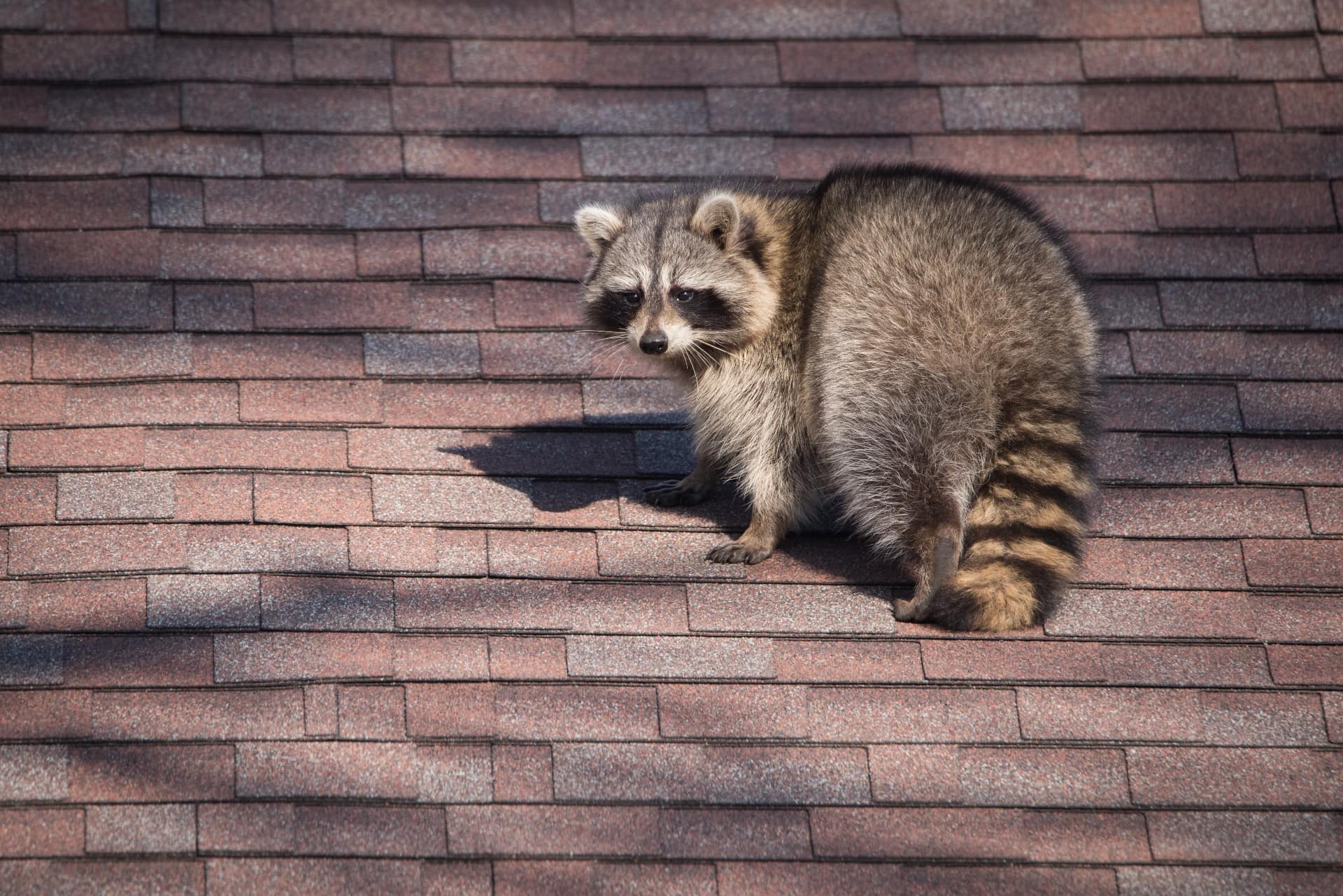
raccoons on the roof
1. Install Pest-Resistant Roofing
To prevent pests especially to prevent raccoons from eating through your roofing shingles. Choose a type that is extremely resilient, impervious to impact, and waterproof.
2. Remove Food Sources
Another easy way to prevent raccoons or get rid of them is to remove the food source. Remove garbage, trash, and other food sources, such as vegetable gardens, fruit trees, and dog food, attract raccoons. By locking garbage cans, storing dog kibble indoors, and clearing your backyard of low-hanging fruit, you can deter raccoons.
3. Use Motion-Activated Deterrents
Floodlights and motion-activated sprinklers are excellent tools for keeping animals out of hard-to-restrict areas of your yard. Installing these is a safe and efficient method of deterring pests like raccoons from entering your house.
4. Fix Current Damage
Raccoons are drawn to gaps in your roof, as we previously discussed, and they will chew at them until they can enter your attic. To keep raccoons off your roof, you should fix any existing roofing damage to your house, such as tiny holes or loose shingles.
Ways to get rid and Prevent raccoons on the wall
Raccoons are adept at locating openings in buildings, such as gaps, fractures, and holes in the siding, roofing, and screens. Once inside the structure, they frequently make dens in isolated spaces like wall voids. To enter the cavity and free the trapped animal, all you have to do is make a hole in the wall. But once you pull the animal out of the wall, you’ll need a cage and protective gloves to keep it from touching you. What is more, property owners must keep their distance from the animals because of these risks. If you have discovered a raccoon infestation, we strongly advise getting in touch with Critter Control’s skilled experts. With the right equipment and expertise, our professionals can remove raccoons from walls and other trouble spots on your property safely and humanely.
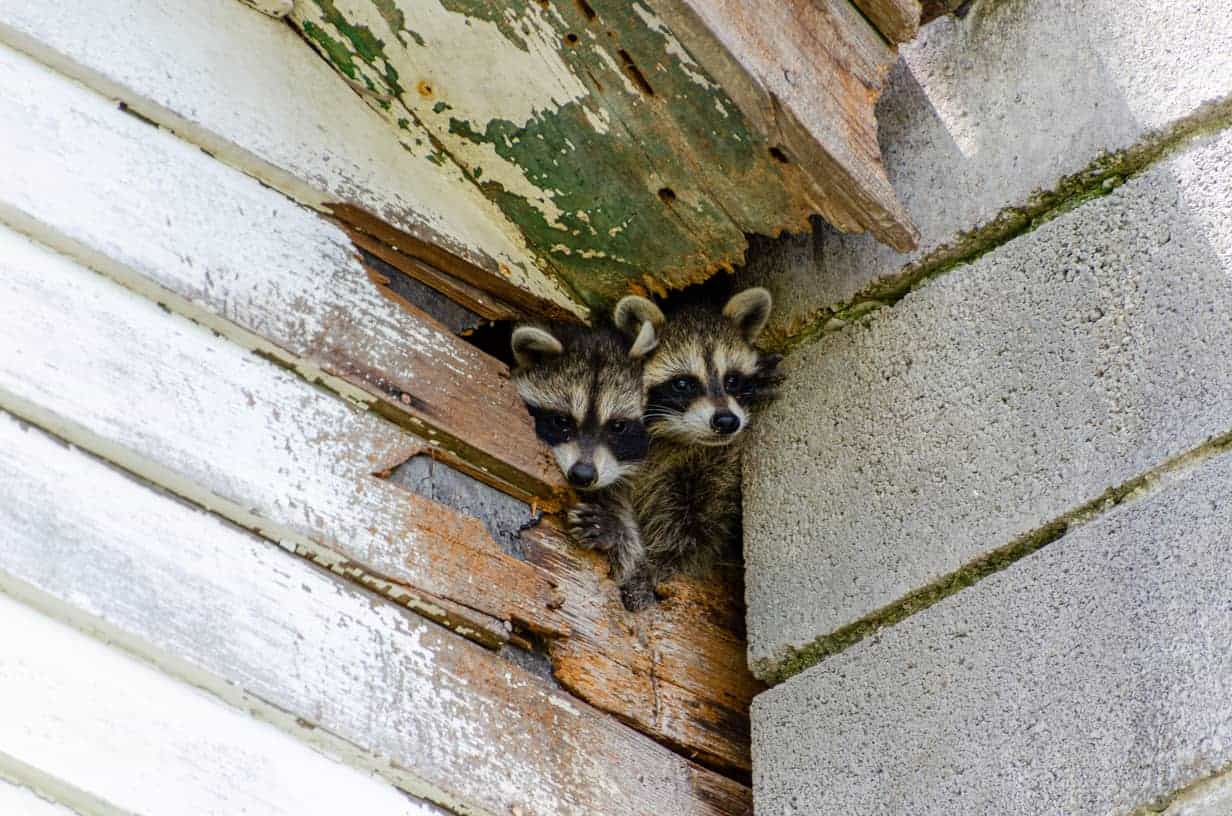
Raccoons in the wall
Ways to get rid and Prevent raccoons at a birdfeeder
There are other robbers in town than squirrels that steal seeds and nuts from bird feeders. It’s no secret that raccoons can be mischievous; one of their many mischievous tendencies is to empty bird feeders. Because squirrels are more adept at climbing and jumping than raccoons are, it may be easier to keep bird feeders out of their reach. The Humane Society suggests hanging bird feeders on the wire that is positioned between two trees or other buildings. Another option is to use feeders that are fastened to poles that have a diameter of less than half an inch; raccoons cannot climb these thin poles. Another thought would be to mount your feeder with raccoon protection. These are available at many locations that sell bird feeders.
As well, raccoons might be drawn to feeders that are out of reach if the seed falls to the ground. This spilled seed will be a feast for many ground-feeding birds, but it can also serve as a free meal for raccoons. The Humane Society suggests using bird feeders made to catch fallen seed or routinely cleaning the area surrounding your feeders to avoid it becoming an issue. Another way to stop spills is to use a feeder with a single kind of seed rather than mixed seeds.
Ways to get rid of and prevent raccoons in the chimney
We consider a chimney to be a great source of warmth and coziness. However, a mother raccoon sees it as the ideal place to raise a brood. Like hollow trees in the woods, chimneys are warm, dark, and safe from predators, which is why raccoons choose them! The mother will keep the infants there until they are big enough to climb, fight, and consume solid food unless you take removal steps. Even if these animals are harmless and objectively adorable, letting them live in your apartment without paying rent is expensive and risky for both of you. Read the guidelines below to find out how to permanently prohibit raccoons from causing problems with your chimney.
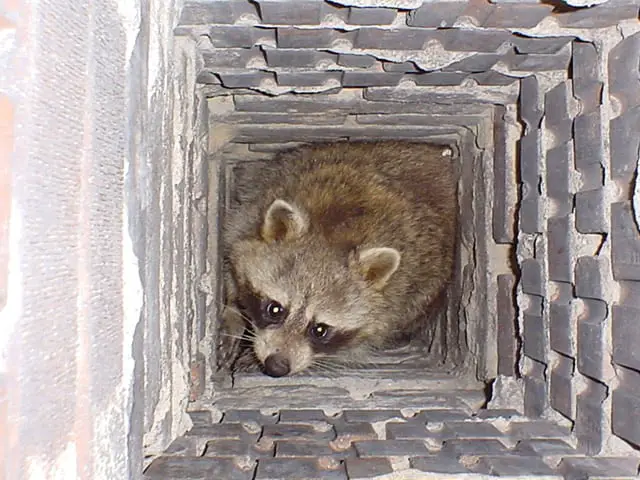
Do not start a fire if a raccoon is in your chimney
You will be roasting young raccoons alive if you do this, even though we think it should go without saying. In fact, there’s a good chance that the raccoons will desperately try to escape through the damper and into your home, wounded and hostile, as you have to open the damper first to allow the smoke to rise. Do not start a fire. Follow the steps below to prevent and get rid of raccoons in your Chimney.
Step 1. Aware of the raccoons in the Chimney
Arrive to the fireplace and introduce yourself. Be loud. Clap loudly on the mantel above. Put a talk radio on a loudspeaker in the fireplace and run it continuously. She may decide to relocate her and all of her offspring out of your chimney overnight if this is sufficient evidence that it is unsafe for her to rear her young. After that, you can install a steel cap on the chimney. Issue resolved! Simple!
Step 2. Use of a dominant male raccoon’s scent
There’s a particular advanced trick if your noise was insufficient to get her to move out. Make use of a dominant male raccoon’s scent. Feminine instincts dictate that a male will kill any offspring, not just their own. We refer to this material as raccoon eviction paste or fluid. You may either open the damper and stick it up there, or soak a towel in it and drop it down the flu. A few babies could fall out and into the fireplace, or the female can bite your fingers if you open the damper. She will be scared of leaving this small space as soon as she detects the perfume, taking her young with her. This is quite likely to work.
Step 3. You can use time as your weapon
You can actually choose to just wait if it doesn’t work. A raccoon can’t harm a chimney. It’s steep pipe and brick! They will urinate, but once they are gone, they may get inflamed. After eight to ten months of life, they will have grown and moved out on their own. It is therefore possible to cover the chimney with a steel cap. You can wait only three months, until they go on nocturnal forages, and then cap the chimney at night if you don’t want to wait that long. Alternatively, you may try intimidating them, as demonstrated here.
Step 4. Risk stage
You will now need to open the damper and manually remove the young’s litter if the eviction fluid does not work and you are not prepared to wait. Usually, there will be three to five young people in a pile together. They are tiny, with closed eyes, and less than three weeks old. By the time they are six or seven weeks old, they will have some degree of mobility. Put on appropriate safety gear (gloves, respirator masks, and headlamps are a good place to start) and gather the litter of newborn raccoons, putting them in a pillowcase. The mother can crawl up the damper or attack your arm. Proceed at your own risk, of course.
Step 5. Take the babies out
You can put the baby outside, close to where she crawls down, in a cardboard box with a blanket and a hot water bottle. Keep an eye on the cardboard box and wait for her to approach it outside before climbing onto the roof and caulking the flu with the appropriate steel cap.
Ways to get rid and prevent raccoons in your chicken coop
More than just smart, raccoons are. They have excellent climbing and digging skills, and they utilize their front paws a lot like humans do, which is both adorable and unsettling. Raccoons are attracted to chicken coops because they know they can find relatively simple prey there. Your chicks are just no match for raccoons without your help. Additionally, in a comparatively short amount of time, a lone raccoon may destroy your flock of hens. A raccoon will probably murder your chickens and consume your eggs if he can get into your chicken house. The raccoon may come back repeatedly to feed on your chickens since it will remember that your chicken house offers easily available captive prey. Read the mentioned processes that assist you in keeping your chickens safe.
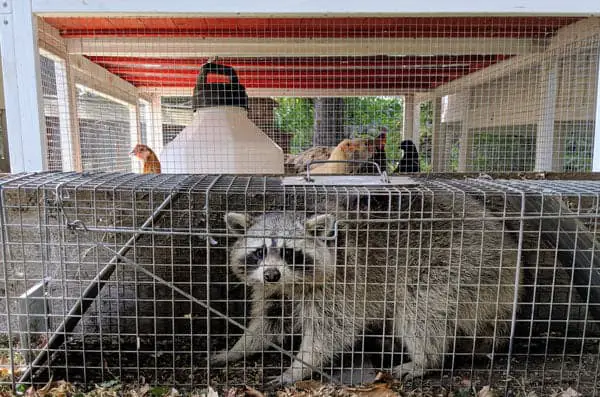
1. Make Your Yard Less Attractive to Raccoons
Reduce the attraction of your yard to raccoons to decrease the likelihood that they will even find your poultry. To prevent raccoons from getting to your wild bird feeders or even the seed on the ground, you can take the following precautions: Pet food should never be left outside if you have other animals, such as dogs or cats, and try to plant foods that raccoons hate. Since raccoons are drawn to water sources, the same applies to dishes of water. To put it briefly, remove anything that might attract raccoons.
2. Secure the Wire Mesh on Your Coop
Raccoons may attempt to bend or pry off any wire mesh that you may have on your coop to obtain entry, so make sure it is secured. Seek out any weak points or regions where the wire mesh isn’t firmly fastened. Consider yourself a predator and scan for any potential points of vulnerability. Relatively, use something more robust, such as hardware cloth with a fine mesh that raccoons cannot sift through, in place of thin chicken wire that they can easily sever. Recall that the purpose of chicken wire is to confine hens inside the coop, not to ward off intruders.
3. Use a Latch That’s Hard to Open
Raccoons are intelligent and can open simple latches without a problem. They typically don’t, however, take the effort to try to figure out how to unlock a complicated latch. Use a latch on your coop that needs to be unlocked in two or three stages. The door latch is equipped with a carabiner clip in the most commonly used two-step manner. By including a carabiner, the raccoons would be forced to open the carabiner and take it out of the latch at the same time to access the latch itself.
4. Surround the Coop Area With Foul Smells
The smells of ammonia, garlic, cayenne pepper, and onions are repulsive to raccoons. By soaking rags in ammonia and placing them in your yard around the perimeter of your chicken coop, you can deter animals from entering your coop. Another option is to apply a homemade raccoon repellent to the outside of your coop. Simply bring a gallon of water to a boil and add a few onions, a few garlic cloves, or a few chili peppers. Then all you have to do is pour the liquid into a spray bottle and use it to mist your chicken coop. To ensure that raccoons stay away, make sure the repellant has a strong scent.
5. Install a Coop Apron
Raccoons may attempt to burrow inside your coop if they are unable to break through the door lock or chicken wire. You ought to install a coop apron for this reason. This includes erecting a PVC-coated wire rolling fence starting at the coop’s base and extending around the outside. This is a less expensive job to take on and is simpler to accomplish than burying fencing material more than a foot deep in the ground.
Ways to get rid and prevent raccoons in a tree
It is not unusual to come across a raccoon that has lodged itself within a tree now and then. Due to their mischievous nature, these small, bothersome animals will find creative ways to enter even the most unlikely spaces. Maybe you can figure out how it truly climbed up into the tree when you see one there. The rodent may have gotten into the tree’s branches by using a power lamp, a branch, or some other method. But when you see it there, you might be curious about how a raccoon could be freed from a tree.

raccoons in tree
You can solve your issue with something like a trap if you don’t want to take things too far. The raccoon will enter a cage and become caught if you place a cage next to the tree and fill it with bait, like bread or peanut butter. After that, you can release the raccoon from your tree by moving the trap to a different spot. Besides, to prevent raccoons from the trees, there are multiple steps to take. Cover birdfeeders, bring pet food inside for the night, and acquire trash can lids that fit tightly to eliminate potential sources of food and water. By decreasing the attractiveness of decorative lawn trees as roost sites, pruning branches also discourages pests.
FAQ
Conclusion
To conclude, though it is common somewhere that people have raccoons as pets and are happy with them, raccoons are wild. Their nature will not alter even if they become your favorite pet. Because they possess unpredictable characteristics that distinguish them from other animals. They become aggressive at certain times, and no one can anticipate when, why, and how. Due to situational behavior and instinctive changes in personality and attitude, most experts suggest that you avoid patting and picking up raccoons as pets.
Raccoons are a sort of nasty animal that usually causes a lot of damage to properties such as yards, attics, bird feeders, chimneys, chicken coops, and even trees. Prevent raccoons from harming your property and causing a disturbance, there are certain ways and methods for encountering raccoons. Study the steps above to find out the best possible approaches to solving raccoon problems in general. Finally, if it is tough for you to deal with a raccoon problem, you can call the nearest responsible organization to assist you and take care of them.



